2020 MERCEDES-BENZ GLA belt
[x] Cancel search: beltPage 44 of 346
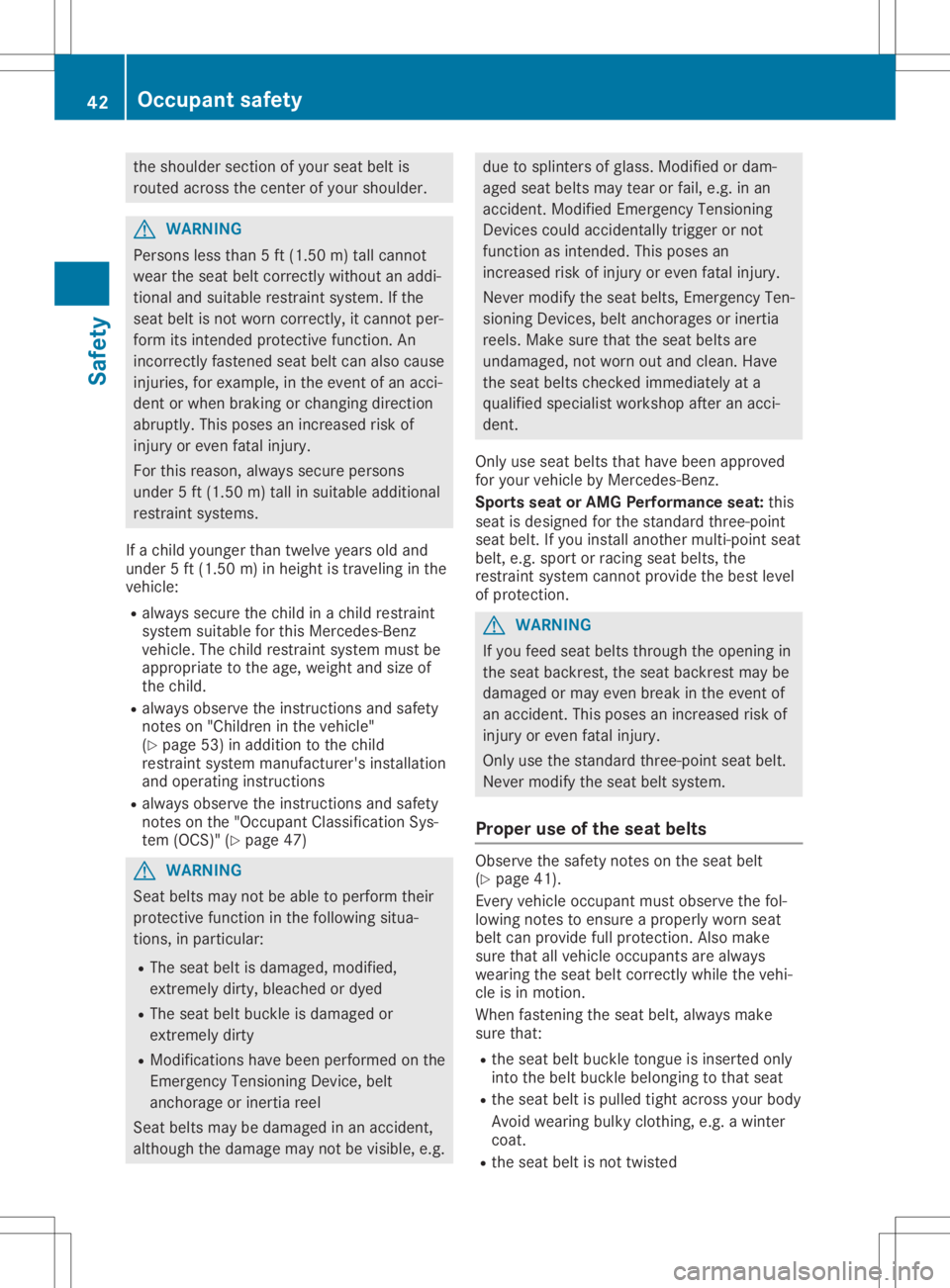
the
shoulde rse ctio nof your seat beltis
rou ted across thecente rof your sho ulde r. G
WA
RNING
Pe rso nsless tha n5 ft (1.5 0m) tallcann ot
we arthe seat beltcorr ectlywi thou tan addi-
tio nal and suita ble res traint syste m. Ifthe
se at beltis not worncorr ectly,itcann otper-
for mits inte ndedpro tecti vefunctio n.An
inco rrectly faste ned seat beltcan also cau se
inju ries,for exa mpl e,inthe eventofan acc i-
de nt or wh en bra king orcha nging directi on
ab ruptl y.Thi spo sesan incr easedris kof
inju ryor eve nfa tal inju ry.
For thisrea son ,al wa yssecur epe rso ns
und er5ft (1.5 0m) tallin suita ble ad ditio nal
res traint syste ms.
If achi ldyoung ertha ntwe lveyearsol d and
und er5ft (1.50 m)inheight istravelin gin the
vehic le:
R always securethe child inachild restraint
syst emsuitable forthis Merc edes- Benz
vehic le.The child restraint systemmust be
appropr iatetothe age, weight andsize of
the child.
R always observethe instruct ions andsafet y
not eson "Children inthe vehic le"
(Y page 53)inaddition tothe child
rest raint systemmanuf acturer' sinst allation
and operat inginst ruct ions
R always observethe instruct ions andsafet y
not eson the "Occ upant Classific ationSys-
tem (OCS)" (Ypage 47) G
WARN
ING
Seat belts maynotbeable toperf orm their
prot ective func tion inthe followin gsitua-
tion s,in part icular:
R The seat beltisdamaged, modified,
ext reme lydirt y,bleache dor dyed
R The seat beltbuck leisdamaged or
ext reme lydirt y
R Modific ationshave been performe don the
Em ergen cyTens ionin gDev ice, belt
anc horage oriner tiareel
Seat belts maybedamaged inan acc ident ,
althoug hthe damage maynotbevisible, e.g. due
tosplin tersof glass. Modifie dor dam-
aged seatbelts maytearorfail, e.g. inan
acc ident .Modifie dEm ergen cyTens ionin g
Dev ices could accident allytrigger ornot
func tion asintended .This poses an
inc reased riskofinjury oreven fatalinj ury.
Never modifythe seat belts ,Em ergen cyTen-
sion ingDev ices, beltanchorage sor iner tia
reels. Make surethattheseat belts are
undamage d,not worn outand clean .Have
the seat belts checkedimmed iatelyata
qualified specialist workshop afteran acc i-
dent .
Only useseat belts thathave been approv ed
for your vehic leby Merc edes- Benz.
Spor tsseat orAMG Performance seat:this
seat isdesign edfor the stan dard three-po int
seat belt. Ifyou installanot hermulti- point seat
belt, e.g.sport orracin gseat belts ,the
rest raint systemcannot prov idethe best level
of prot ection. G
WARN
ING
If you feed seatbelts through theopen ingin
the seat backrest,the seat backrestmay be
damaged ormay even break inthe even tof
an acc ident .This poses anincreased riskof
inj ury oreven fatalinj ury.
Only usethestan dard three-po intseat belt.
Never modifythe seat beltsystem.
Prop eruse oftheseat belts Obser
vethe safet ynot eson the seat belt
(Y page 41).
Ev ery vehic leocc upant mustobservethe fol-
lowing notestoens ure aproper lyworn seat
belt canprov idefull prot ection. Also make
sure thatallvehic leocc upant sare always
wearin gthe seat beltcorrectlywhile thevehi-
cle isin mot ion.
When fastenin gthe seat belt, always make
sure that:
R the seat beltbuck leton gue isinse rted only
int othe belt buck lebelon gingtothat seat
R the seat beltispulled tightacro ssyour body
Av oid wearin gbulky clothing ,e.g. awint er
coat .
R the seat beltisnot twist ed 42
Occupa
ntsaf etySaf ety
Page 45 of 346
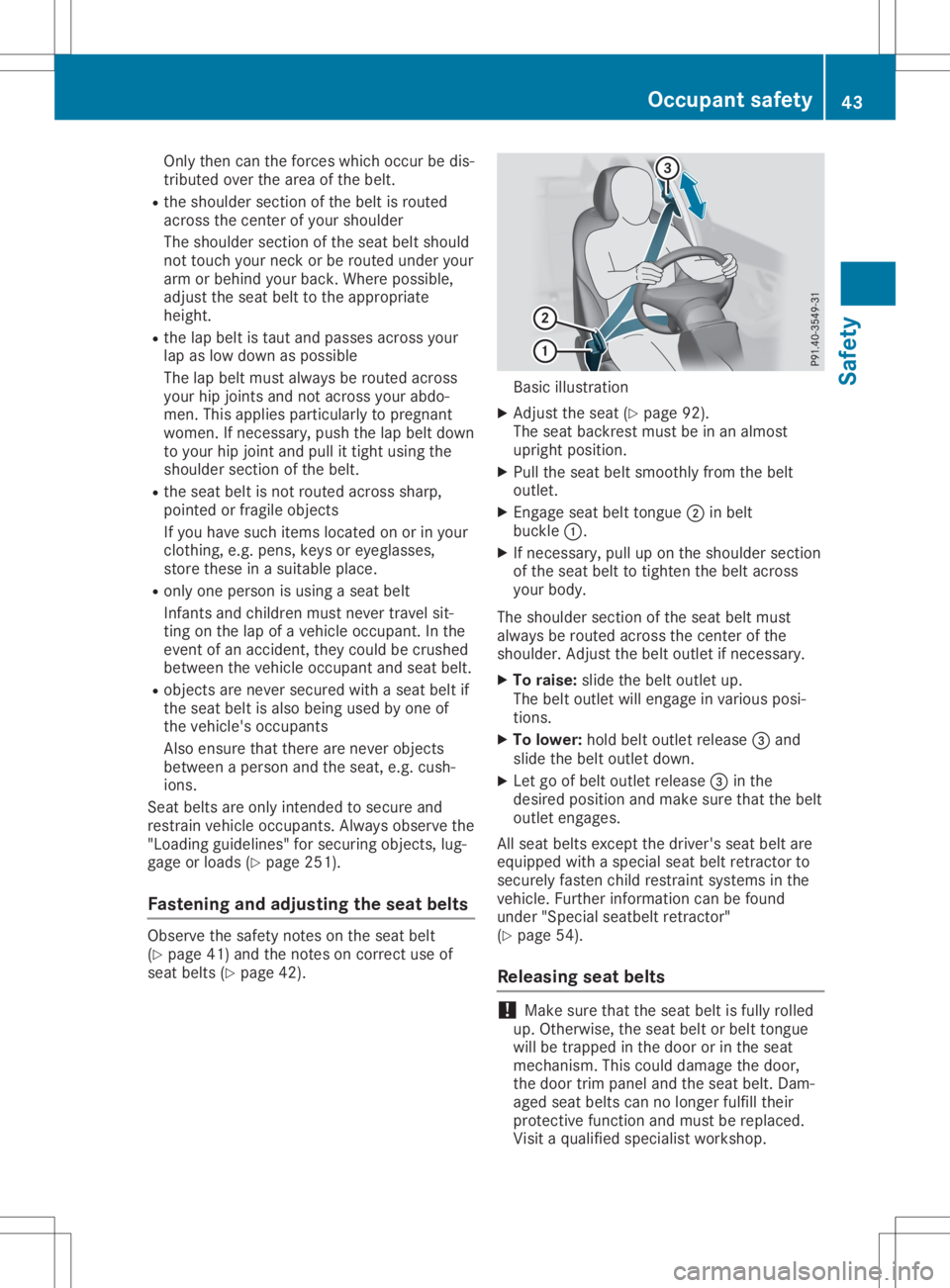
Only
thencantheforces whichoccurbedis-
tributed overthearea ofthe belt.
R the shoulde rsection ofthe belt isrouted
across thecenter ofyour shoulde r
The shoulde rsection ofthe seat beltshould
not touch yourneck orbe routed underyour
arm orbehind yourback. Where possible ,
adjust theseat belttothe appropria te
height.
R the lapbelt istaut andpasses acrossyour
lap aslow down aspossible
The lapbelt must alwaysbe routed across
your hipjoints andnotacross yourabdo-
men. Thisappli esparticularl yto pregnant
women. Ifnecessary, pushthelapbelt down
to your hipjoint andpullittight using the
shoulde rsection ofthe belt.
R the seat beltisnot routed across sharp,
pointed orfragile objects
If you have such items located onorinyour
clothing, e.g.pens, keysoreyegl asses,
store these inasuitabl eplace.
R only oneperson isusing aseat belt
Infant sand children mustnever travel sit-
ting onthe lapofavehicle occupant. Inthe
event ofan accident, theycould becrushed
between thevehicle occupant andseat belt.
R objects arenever secured withaseat beltif
the seat beltisalso being usedbyone of
the vehicle's occupants
Also ensure thatthere arenever objects
between aperson andtheseat, e.g.cush-
ions.
Seat belts areonly intended tosecure and
restrain vehicleoccupants. Alwaysobserve the
"Loadi ngguide lines" forsecuring objects,lug-
gage orloads (Ypage 251).
Fastening andadjusting theseat belts Observe
thesafety notesonthe seat belt
(Y page 41)and thenotes oncorrect useof
seat belts (Ypage 42). Basic
illustration
X Adjust theseat (Ypage 92).
The seat backrest mustbeinan almost
upright position.
X Pull theseat beltsmoothly fromthebelt
outlet.
X Engage seatbelttongue 0044inbelt
buckle 0043.
X Ifnecessary, pullupon the shoulde rsection
of the seat belttotighten thebelt across
your body.
The shoulde rsection ofthe seat beltmust
alwa ysbe routed across thecenter ofthe
shoulde r.Adjust thebelt outlet ifnecessary.
X To raise: slidethebelt outlet up.
The belt outlet willengage invarious posi-
tions.
X To lowe r:hold beltoutlet release 0087and
slide thebelt outlet down.
X Let goofbelt outlet release 0087inthe
desired position andmake surethatthebelt
outlet engages.
All seat belts except thedriver's seatbeltare
equip pedwith aspecial seatbeltretractor to
securely fastenchildrestraint systemsinthe
vehicle. Furtherinformation canbefound
under "Special seatbeltretractor"
(Y page 54).
Releasing seatbelts !
Make
surethattheseat beltisfully rolled
up. Otherwise, theseat beltorbelt tongue
will betrapped inthe door orinthe seat
mechanism. Thiscould damage thedoor,
the door trimpanel andtheseat belt. Dam-
aged seatbelts cannolonger fulfilltheir
protective functionandmust bereplaced.
Visit aqual ified speciali stworkshop. Occ
upant safety
43Safety Z
Page 46 of 346
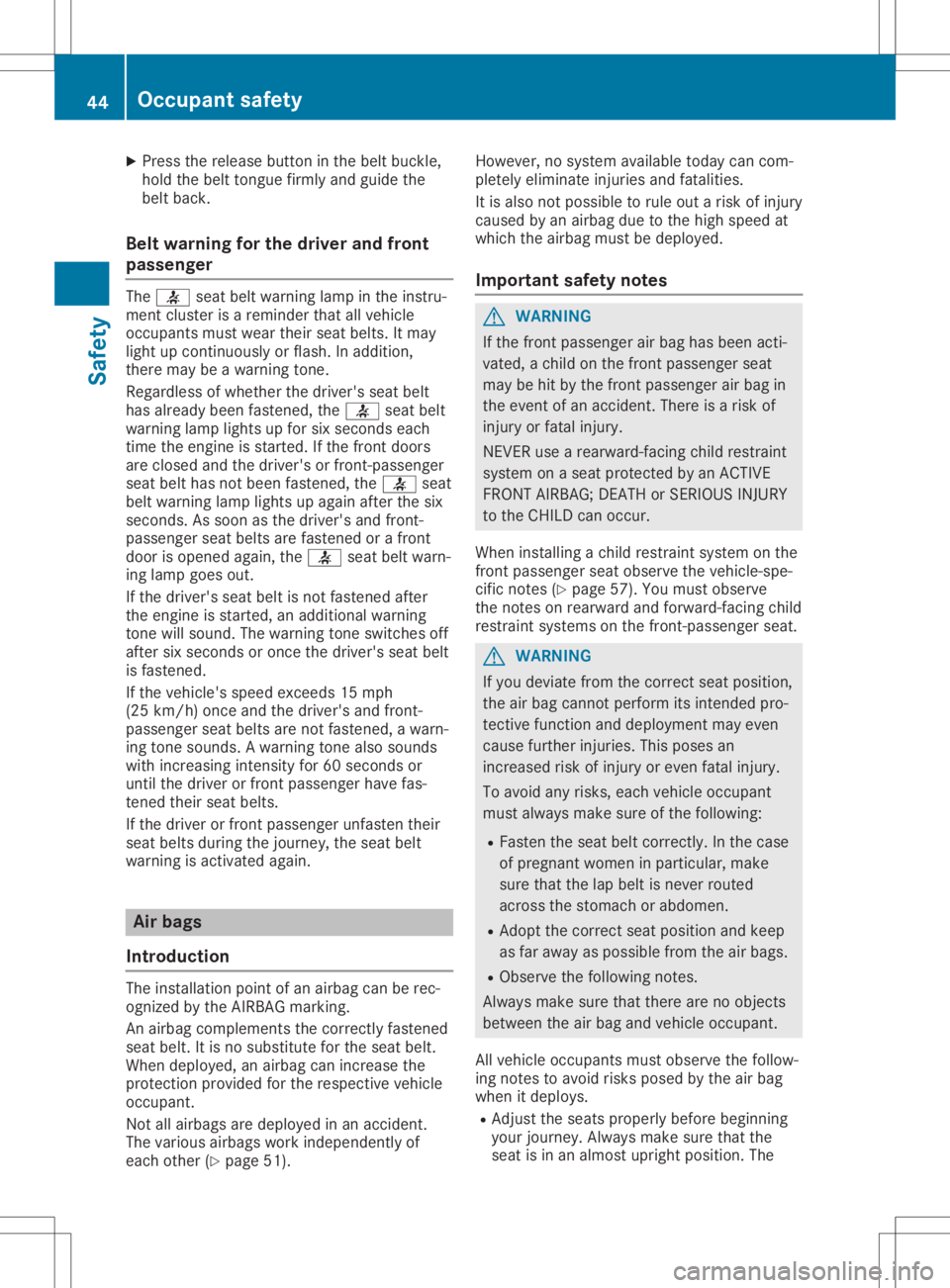
X
Press therelease buttoninthe belt buckle,
hold thebelt tongue firmly andguide the
belt back.
Belt warning forthe driver andfront
passenger The
0076 seatbeltwarning lampinthe instr u-
ment cluster isareminder thatallvehicle
occupant smust weartheirseatbelts. Itmay
light upcont inuously orflash. Inaddition,
there maybeawarning tone.
Regardless ofwhether thedriver's seatbelt
has already beenfasten ed,the 0076 seatbelt
warning lamplights upfor sixseconds each
time theengine isstart ed.Ifthe fron tdoors
are closed andthedriver's orfron t-passenger
seat belthasnotbeen fasten ed,the 0076 seat
belt warning lamplights upagain afterthesix
seconds .As soon asthe driver's andfront-
passenger seatbelts arefasten edorafron t
door isopened again,the0076 seatbeltwarn-
ing lamp goesout.
If the driver's seatbeltisnot fasten edafter
the engine isstart ed,anadditional warning
ton ewill sound. Thewarning toneswitches off
after sixseconds oronce thedriver's seatbelt
is fasten ed.
If the vehicle's speedexceeds 15mph
(25 km/ h)once andthedriver's andfront-
passenger seatbelts arenot fasten ed,awarn-
ing tonesounds. Awarning tonealso sounds
with increasin ginten sityfor60seconds or
until thedriver orfron tpassenger havefas-
tened theirseatbelts.
If the driver orfron tpassenger unfastentheir
seat belts during thejourney, theseat belt
warning isactivat edagain. Air
bags
Introdu ction The
installation pointofan airbag canberec-
ognized bythe AIRBA Gmarkin g.
An airbag complemen tsthe correc tlyfasten ed
seat belt. Itis no substitut efor the seat belt.
When deployed, anairbag canincrease the
protec tionprovided forthe respect ivevehicle
occupant .
Not allairbags aredeployed inan accident .
The various airbags workindependen tlyof
each other (Ypage 51). However,
nosystem availabletoday cancom-
pletely eliminate injuriesandfatalities.
It is also notpossible torule outarisk ofinjury
caused byan airbag duetothe high speed at
which theairbag mustbedeployed.
Impor tantsafety notes G
WARNIN
G
If the fron tpassenger airbag hasbeen acti-
vated, achild onthe fron tpassenger seat
may behit bythe fron tpassenger airbag in
the event ofan accident .There isarisk of
injury orfatal injury.
NEVE Ruse arearward-facin gchild restraint
system onaseat protec tedbyan ACTIVE
FRONT AIRBAG;DE ATH orSERIOU SINJURY
to the CHILD canoccur.
When installing achild restraintsystem onthe
fron tpassenger seatobserve thevehicle-spe-
cific notes(Y page 57).Youmust observe
the noteson rearward andforward-f acingchild
restr aintsystems onthe fron t-passenger seat. G
WARNIN
G
If you deviate fromthecorrec tseat position,
the airbag cann otperform itsinten dedpro-
tect ivefunct ionand deployment mayeven
cause further injuries. Thisposes an
increased riskofinjury oreven fatalinjury.
To avoid anyrisks, eachvehicle occupant
must alway smake sureofthe following:
R Fasten theseat beltcorrec tly.Inthe case
of pregnant womeninparticular, make
sure thatthelapbelt isnever routed
across thestomac hor abdomen.
R Adopt thecorrec tseat position andkeep
as far away aspossible fromtheairbags.
R Observe thefollowing notes.
Always makesurethatthere arenoobject s
between theairbag and vehicle occupant .
All vehicle occupant smust observe thefollow-
ing notestoavoid risksposed bythe airbag
when itdeploys.
R Adjust theseats properly beforebeginnin g
your journey. Alwaysmakesurethatthe
seat isin an almost upright position. The 44
Occupant
safetySafety
Page 47 of 346
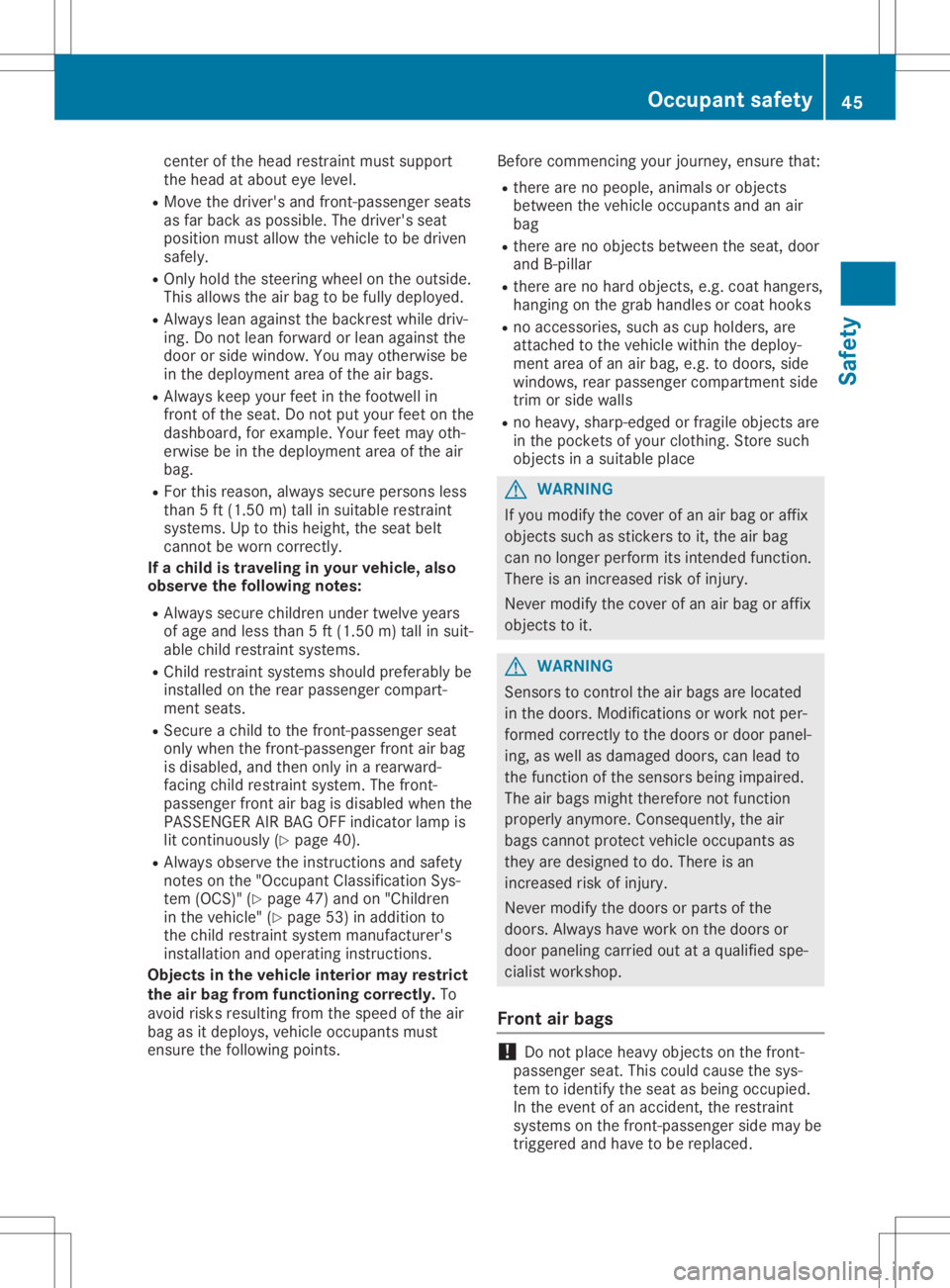
center
ofthe headrestra intmus tsu ppo rt
the headat abou tey elevel .
R Move thedriver' sand front-pa ssenger seats
as far back aspos sible.The driver' ssea t
pos ition mus tal low thevehi cletobe driven
saf ely.
R Only holdthe stee ring wheelon the outsid e.
Thi sal low sthe airba gto be fullydep loyed.
R Alw aysle an against the backrest whiledri v-
ing. Donot lean forw ardorlean against the
doo ror sid ewi ndow .You may otherwisebe
in the deployment areaof the airba gs.
R Alw ayskeep your fee tin the footw ellin
front ofthe seat.Do not putyo ur fee ton the
da shb oard, for exa mpl e.You rfee tmay oth-
erw isebeinthe deployment areaof the air
ba g.
R For this reason, alwa yssecu reper sons less
than 5ft (1.50 m)tallin suita ble res traint
sy ste ms. Uptothishe ight, the seat belt
cann otbe worncorr ectly.
If ach ild is trave ling inyour vehic le,als o
ob serve the follow ingno tes :
R Alw aysse cur echi ldren undertwe lveyears
of ageand less tha n5 ft (1.5 0m) tallin suit-
ab lechi ldres traint syste ms.
R Ch ild res traint syste ms should pre ferablybe
ins talled on the rearpa sse nge rcomp art-
ment seats .
R Secu reachi ldto the front-pa ssenge rse at
onl ywh en the front-pa ssenge rfro ntairba g
is disa bled ,and thenonl yin area rward-
fa cing childres traint syste m. The front-
pa sse nge rfro ntairba gis disa bled when the
PASSEN GERAIRBAG OFFindicator lamp is
li t conti nuously(Y page 40).
R Alw aysob serve the instructio nsand safety
note son the "Occu pant Clas sific ati on Sys -
tem (OCS) "(Y page 47) and on"Child ren
in the vehicle" (Y page 53)in ad ditio nto
the childres traint syste mma nuf actu rer's
ins tallatio nand opera ting instructio ns.
Ob jec tsinthe vehic leinteri ormay restric t
the airbag fromfun ctioningco rrec tly.To
av oid ris ks res ulting fromthe spee dof the air
ba gas itde ploy s,veh icleoccu pants must
ens urethe followi ng points . Befo
recomm encingyour jou rney ,ens uretha t:
R the reareno peop le,ani ma lsor objects
be twe enthe vehicleoccu pants and anair
ba g
R the reareno objects betwe enthe seat, door
and B-pillar
R the reareno hard objects ,e.g .coa tha nge rs,
ha ngi ng on the grabha ndl esorcoa thoo ks
R no acc essor ies, su ch ascup holders, are
atta chedto the vehiclewi thi nthe deploy -
ment area ofan airba g,e.g .to doors ,si de
wi ndo ws,rea rpa sse nge rcomp artment side
trim orside walls
R no heavy, sha rp-e dged orfra gile ob jects are
in the pockets ofyour clo thing. Store such
ob jects inasu ita ble place G
WA
RNING
If yo umod ifythe cove rof an airba gor affix
ob jects such assticker sto it,the airba g
can nolonge rpe rfo rm itsinte ndedfu nctio n.
The reisan incr easedris kof inju ry.
Nev ermod ifythe cove rof an airba gor affix
ob jects toit. G
WA
RNING
Sens orstocontro lthe airba gs arelocate d
in the doors .Mod ificati ons orwo rknot per-
for med correctlyto the doors ordoor panel -
ing ,as wellas dama geddo ors ,can lead to
the functio nof the senso rsbeing impaire d.
The airba gs might therefore not functio n
pro perly any mor e.Co nse quentl y,the air
ba gs cann otpro tect vehicleoccu pants as
the yar ede signe dto do.The reisan
incr easedris kof inju ry.
Nev ermod ifythe doors orparts ofthe
do ors .Alw aysha ve workon the doors or
do or panel ing carriedou tat aqu alifi ed spe-
cia list wo rksh op.
Fro ntair bag s !
Do
not place heavyob jects onthe front-
pa sse nge rse at. Thiscou ldcau sethe sys-
tem toidenti fythe seat as being occu pied .
In the eventofan acc ident, therestraint
sy ste ms onthe front-pa ssenge rsi de maybe
trig gered and have tobe rep laced . Oc
cupant safety
45Safety Z
Page 49 of 346
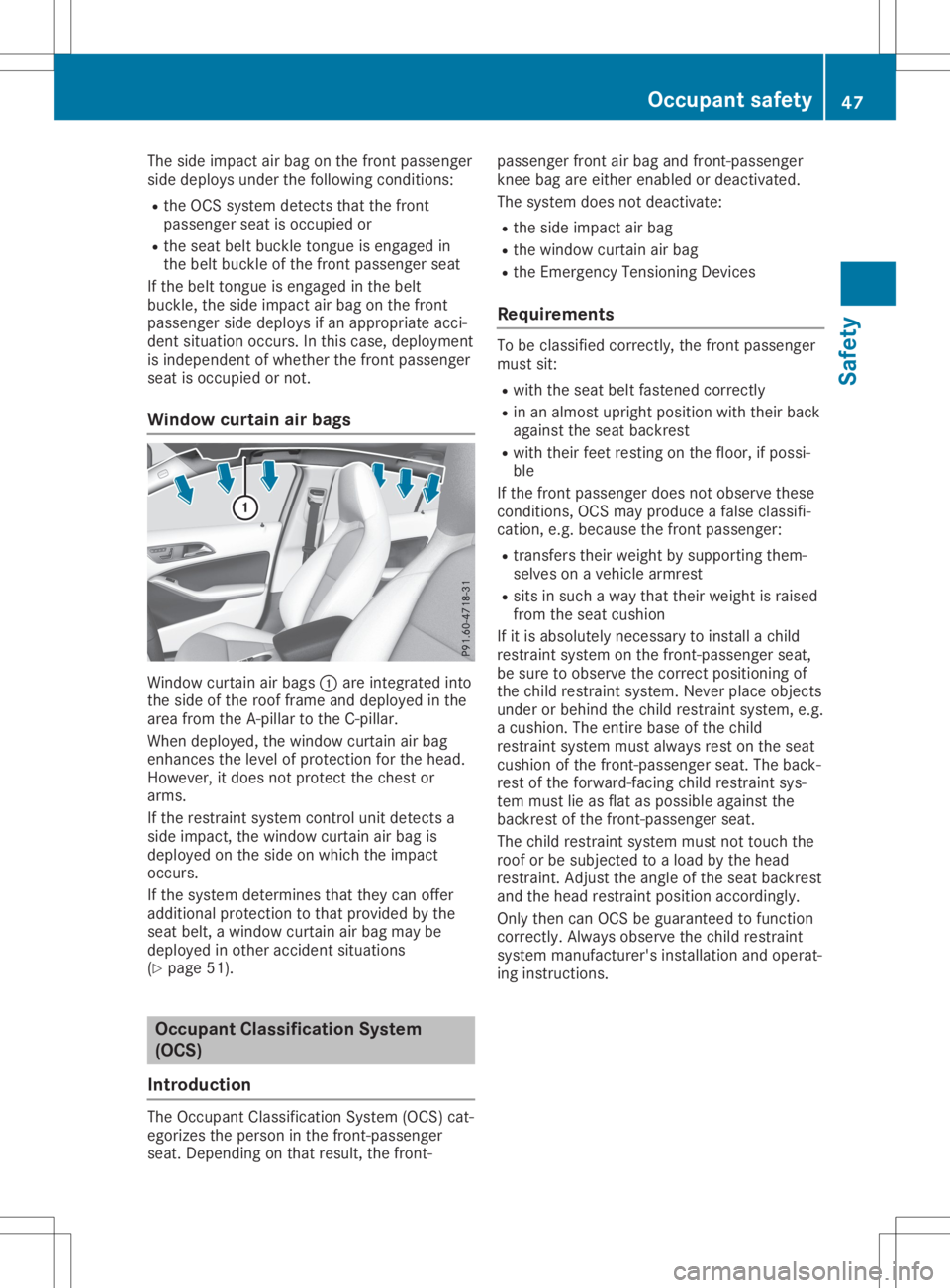
The
side impact airbag onthe front passenger
side deploys underthefollowing conditions:
R the OCS system detectsthat thefront
passenger seatisoccupied or
R the seat beltbuckle tongue isengaged in
the belt buckle ofthe front passenger seat
If the belt tongue isengaged inthe belt
buckle, theside impact airbag onthe front
passenger sidedeploys ifan appropriate acci-
dent situation occurs.Inthis case, deployment
is independent ofwhether thefront passenger
seat isoccupied ornot .
Window curtainairbags Window
curtainairbags 0043are integr atedinto
the side ofthe roof frame anddeployed inthe
area from theA-pillar tothe C-pillar.
When deployed, thewindow curtainairbag
enhanc esthe level ofprotec tionforthe head.
However, itdoes notprotec tthe chest or
arms.
If the restr aintsystem controlunit detect sa
side impact, thewindow curtainairbag is
deployed onthe side onwhich theimpact
occurs.
If the system determin esthat they canoffer
additional protectiontothat provided bythe
seat belt, awindow curtainairbag may be
deployed inother accident situations
(Y page 51). Occupant
Classification System
(OCS)
Introdu ction The
Occupant Classification System(OCS)cat-
egorizes theperson inthe front -passenger
seat. Dependin gon that result, thefront - passenger
frontairbag and front -passenger
knee bagareeither enabled ordeactivated.
The system doesnotdeactivate:
R the side impact airbag
R the window curtainairbag
R the Emergen cyTensionin gDevices
Requir ements To
be classified correctly,the front passenger
must sit:
R with theseat beltfasten edcorrec tly
R in an almost upright position withtheir back
against theseat backrest
R with their feetrestin gon the floor, ifpossi-
ble
If the front passenger doesnotobserve these
condit ions,OCSmayproduce afalse classifi-
cation, e.g.because thefront passenger:
R trans ferstheir weight bysupporting them-
selves onavehicle armrest
R sits insuch away that their weight israised
from theseat cushion
If it is absolutely necessarytoinstall achild
restr aintsystem onthe front -passenger seat,
be sure toobserve thecorrec tpositionin gof
the child restraintsystem. Neverplaceobject s
under orbehind thechild restraintsystem, e.g.
a cushion. Theentir ebase ofthe child
restr aintsystem mustalway srest onthe seat
cushion ofthe front -passenger seat.Theback-
rest ofthe forward-fac ingchild restraintsys-
tem must lieasflat aspossible againstthe
backrest ofthe front -passenger seat.
The child restraintsystem mustnottouch the
roof orbe subject edtoaload bythe head
restr aint. Adjust theangle ofthe seat backrest
and thehead restraintposition according ly.
Only thencanOCS beguaranteed tofunct ion
correc tly.Always observe thechild restraint
system manufact urer'sinstallation andoperat-
ing instr uctions . Occupant
safety
47Safety Z
Page 51 of 346
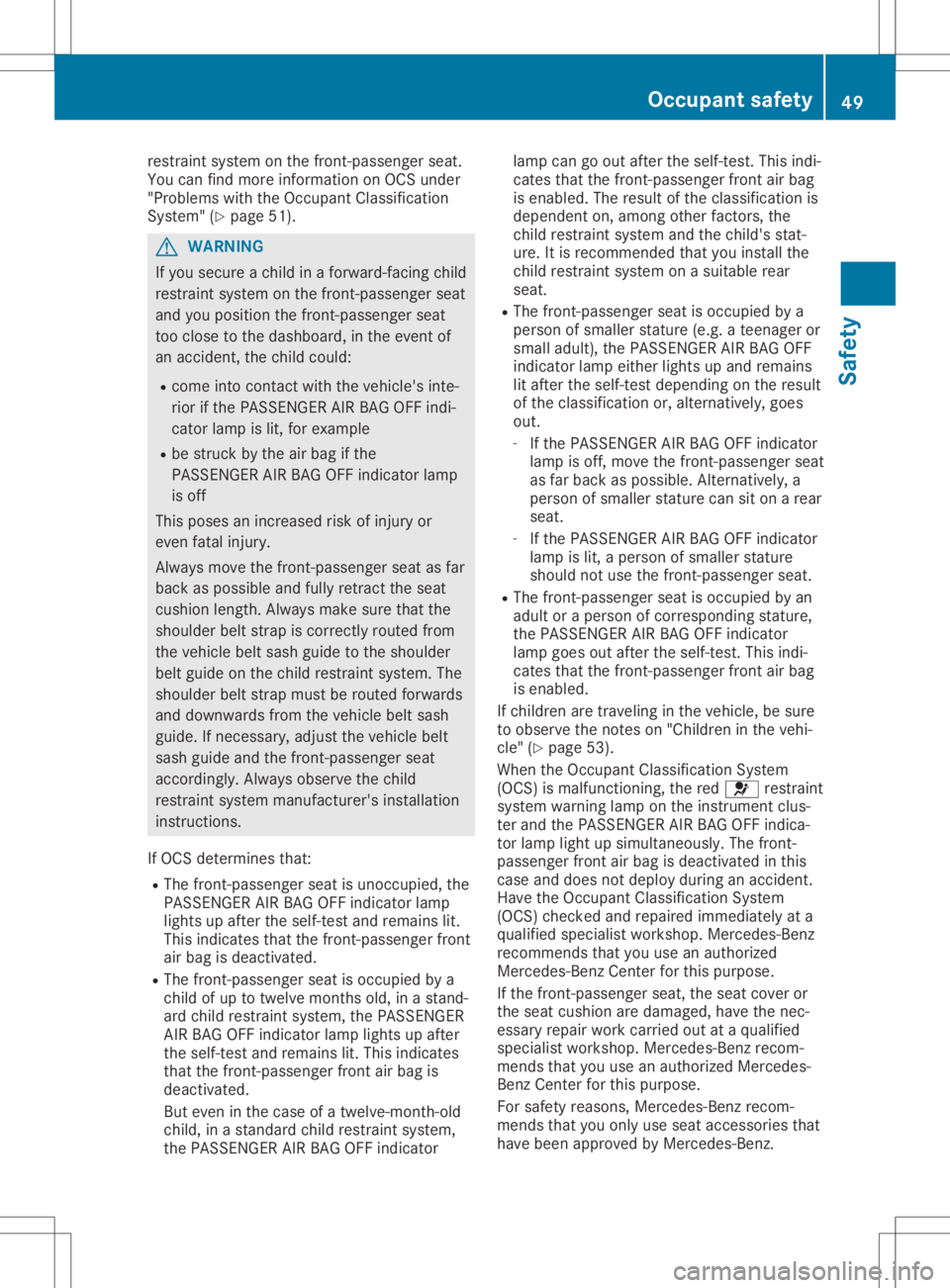
restrai
ntsystem onthe front-passenge rseat.
You canfind more informatio non OCS under
"Prob lemswiththeOccupa ntCla ssifi cation
System" (Ypag e51). G
WARNING
If you secure achild inaforwa rd-facing child
restrai ntsystem onthe front-passenge rseat
and youposition thefront-passenge rseat
too close tothe dash board,inthe event of
an accide nt,the child could :
R come intocontact withthevehicl e'sinte-
rior ifthe PASSENGER AIRBAG OFFindi-
cator lampislit, for exampl e
R be struck bythe airbag ifthe
PASSENGER AIRBAG OFFindica torlamp
is off
This poses anincrease drisk ofinjury or
even fatalinjury.
Alwa ysmove thefront-passenge rseat asfar
back aspossi bleand fullyretract theseat
cushi onlength. Alwaysmake surethatthe
shou lderbeltstrap iscorrectly routedfrom
the vehicl ebelt sash guide tothe shou lder
belt guide on the child restrai ntsystem. The
shou lderbeltstrap mustberouted forwards
and downw ardsfrom thevehicl ebelt sash
gui de. Ifnecessary ,adju stthe vehicl ebelt
sash guide and thefront-passenge rseat
accordi ngly.Alwaysobserve thechild
restrai ntsystem manufacturer's installation
instructions.
If OCS determine sthat:
R The front-passenge rseat isunoccup ied,the
PASSENGER AIRBAG OFFindica torlamp
lig hts upafter theself-test andremai nslit.
This indica testhat thefront-passenge rfront
air bag isdea ctivated.
R The front-passenge rseat isoccupi edbya
child ofup totwelve months old,inastand-
ard child restrai ntsystem, thePASSENGER
AIR BAG OFFindica torlamp lights upafter
the self-test andremai nslit. This indica tes
that thefront-passenge rfront airbag is
dea ctivated.
But even inthe case ofatwelve -month-old
child ,in astandard childrestrai ntsystem,
the PASSENGER AIRBAG OFFindica tor lamp
cangoout after theself-test. Thisindi-
cates thatthefront-passenge rfront airbag
is enabl ed.The resul tof the class ification is
depe ndent on,among otherfactors, the
child restrai ntsystem andthechild 'sstat-
ure. Itis recommended thatyouinstall the
child restrai ntsystem onasui table rear
seat.
R The front-passenge rseat isoccupi edbya
person ofsmal lerstature (e.g.ateenage ror
smal ladu lt),the PASSENGER AIRBAG OFF
indica torlamp either lights upand remai ns
lit after theself-test depending onthe resul t
of the class ification or,alterna tively,goes
out.
- Ifthe PASSENGER AIRBAG OFFindica tor
lamp isoff, move thefront-passenge rseat
as far back aspossi ble.Alternativel y,a
person ofsmal lerstature cansiton arear
seat.
- Ifthe PASSENGER AIRBAG OFFindica tor
lamp islit, aperson ofsmal lerstature
shou ldnot use thefront-passenge rseat.
R The front-passenge rseat isoccupi edbyan
adu ltor aperson ofcorrespond ingstature,
the PASSENGER AIRBAG OFFindica tor
lamp goesoutafter theself-test. Thisindi-
cates thatthefront-passenge rfront airbag
is enabl ed.
If child renaretraveli nginthe vehicl e,be sure
to observe thenotes on"Child ren inthe vehi-
cle" (Ypag e53) .
When theOccupa ntCla ssifi cation System
(OC S)ismalfu nctioning, thered 0075 restrai nt
system warninglamp onthe instrument clus-
ter and thePASSENGER AIRBAG OFFindica -
tor lamp light up simu ltaneou sly.The front-
pass enger frontairbag isdea ctivated inthis
case anddoes notdepl oyduri nganaccide nt.
Have theOccupa ntCla ssifi cation System
(OC S)checked andrepa iredimmed iatelyat a
qua lified specia listworkshop .Mercede s-Benz
recommends thatyouuseanauthorized
Mercede s-BenzCenter forthis purp ose.
If the front-passenge rseat, theseat cover or
the seat cushi onare dama ged,have thenec-
essa ryrepa irwork carrie dout ataqua lified
specia listworkshop .Mercede s-Benzrecom-
mends thatyouuseanauthorized Mercede s-
Benz Center forthis purp ose.
For safety reasons,Mercede s-Benzrecom-
mends thatyouonly useseat accessori esthat
have been approved byMercede s-Benz. Occ
upant safety
49Safety Z
Page 52 of 346
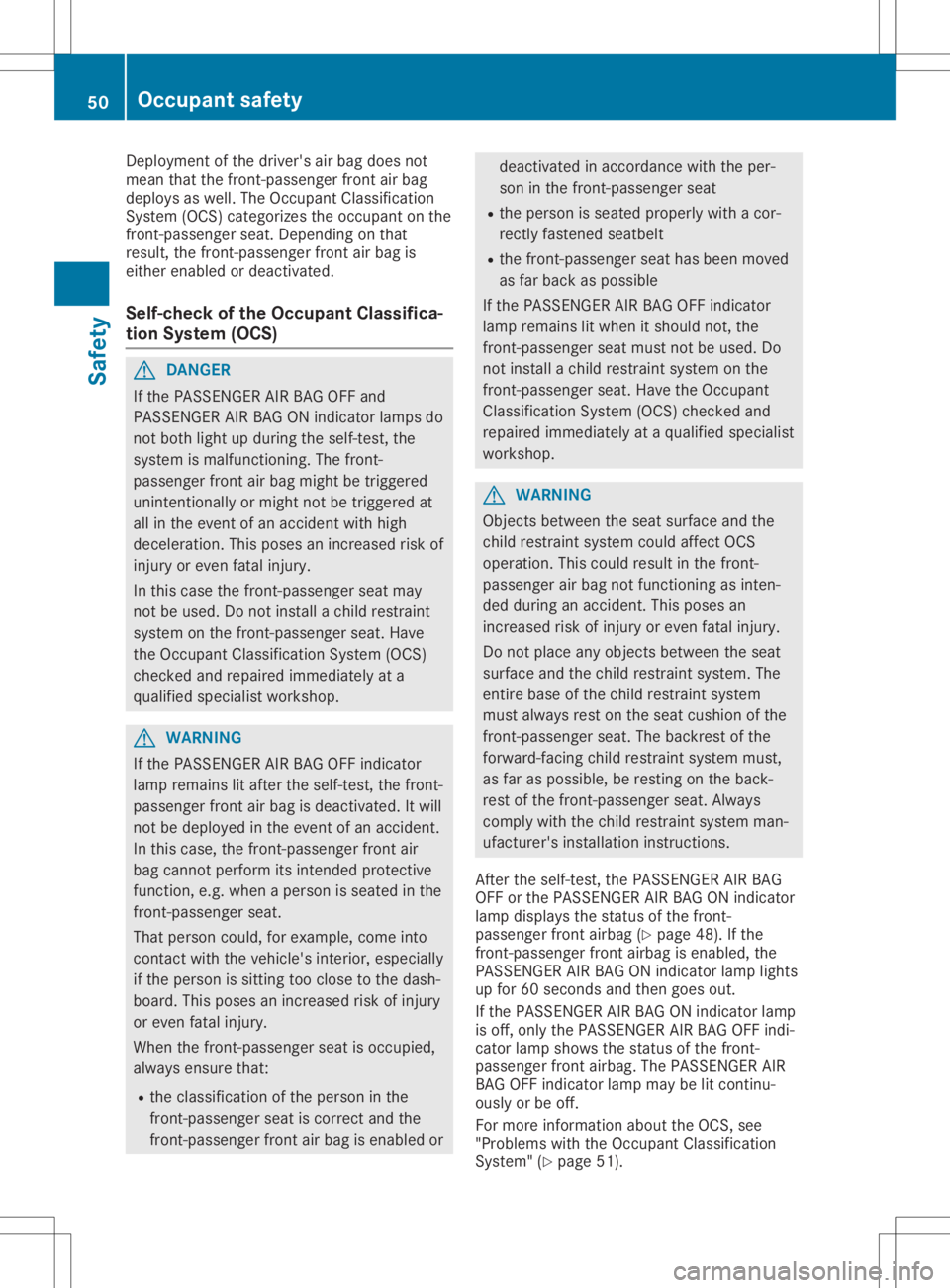
Dep
loym ent ofthe driver 'sairba gdo es not
mea ntha tthe front-pa ssenge rfro ntairba g
de ploy sas well. The Occu pant Clas sific ati on
Sys tem (OCS) cate gorize sthe occu pant on the
fro nt-pa ssenge rsea t.Dep endingontha t
res ult, the front-pa ssenge rfro ntairba gis
ei the rena bled ordeacti vated .
Se lf-ch eckof the Occupant Class ifica -
tio nSys tem (OCS ) G
DA
NGE R
If the PASSEN GERAIRBAG OFFand
PASSEN GERAIRBAG ONindicator lamps do
not both light updurin gthe self-tes t,the
sy stem isma lfunctio ning.The front-
pa sse nge rfro ntairba gmig htbe trig gered
uni ntenti onally or mig htnot betrig gered at
al lin the eventofan acc ident with high
de cel era tion.Thi spo ses anincr eased riskof
inju ryor eve nfa tal inju ry.
In thi scas ethe front-pa ssenge rsea tma y
not beused .Do not installa chi ldres traint
sy stem onthe front-pa ssenge rsea t.Hav e
the Occu pant Clas sific ati on Sys tem (OCS)
che cked andrepaired imm ediatel yat a
qu alifi ed speci alistwo rksh op. G
WA
RNING
If the PASSEN GERAIRBAG OFFindicator
la mp rem ains lit af ter the self-tes t,the front-
pa sse nge rfro ntairba gis de acti vated .It wi ll
not bedeploy ed inthe eventofan acc ident.
In thi scas e,the front-pa ssenge rfro ntair
ba gcanno tpe rfo rm itsinte ndedpro tecti ve
fu nctio n,e.g .wh en ape rso nis sea ted inthe
fro nt-pa ssenge rsea t.
Tha tpe rso ncou ld,for exa mpl e,come into
conta ctwith the vehicle's inte rior,esp ecially
if the perso nis sitting tooclosetothe dash-
bo ard. Thi spo ses anincr eased riskof inju ry
or eve nfa tal inju ry.
Wh enthe front-pa ssenge rsea tis occu pied ,
al wa ysens uretha t:
R the classificati on ofthe perso nin the
fro nt-pa ssenge rsea tis corr ectand the
fro nt-pa ssenge rfro ntairba gis ena bled or de
acti vated inacc ordance with the per-
son inthe front-pa ssenge rsea t
R the perso nis sea ted properly with acor-
rectl yfa sten edsea tbelt
R the front-pa ssenge rsea tha sbe en mov ed
as farba ck aspossi ble
If the PASSEN GERAIRBAG OFFindicator
la mp rem ains lit wh en itsho uld not, the
fro nt-pa ssenge rsea tmu stnot beused .Do
not installa chi ldres traint system onthe
fro nt-pa ssenge rsea t.Hav ethe Occu pant
Cl as sific ati on Sys tem (OCS) checked and
rep aired imm ediatel yat aqu alifi ed speci alist
wo rksh op. G
WA
RNING
Ob jects betwe enthe seatsu rfa ce and the
chi ldres traint system couldaffect OCS
op era tion.Thi scou ldres ultin the front-
pa sse nge rai rba gnot functio ningasinte n-
de ddu rin gan acc ident. Thispo ses an
incr eased riskof inju ryor eve nfa tal inju ry.
Do not place anyobjects betwe enthe seat
su rfa ce and thechildres traint system .The
enti rebase ofthe childres traint system
mu stalwa ysres ton the seatcus hion ofthe
fro nt-pa ssenge rsea t.The backres tof the
for wa rd-f acing childres traint system must,
as faras possi ble, be res ting onthe back-
res tof the front-pa ssenge rsea t.Alw ays
comp lywith the childres traint system man-
uf actu rer'sins tallatio nins tructio ns.
After theself-tes t,the PASSEN GERAIRBAG
OFF orthe PASSEN GERAIRBAG ONindicator
la mp disp lays the status ofthe front-
pa sse nge rfro ntairba g(Y page 48).Ifthe
fro nt-pa ssenge rfro ntairba gis ena bled ,the
PASSEN GERAIRBAG ONindicator lamp lights
up for 60sec ond sand thengo es out.
If the PASSEN GERAIRBAG ONindicator lamp
is off ,onl ythe PASSEN GERAIRBAG OFFindi-
cato rla mp showsthe status ofthe front-
pa sse nge rfro ntairba g.The PASSEN GERAIR
BAG OFFindicator lamp maybe lit conti nu-
ou sly or be off.
For mor einfo rma tionab ou tthe OCS,see
"P rob lems with the Occu pant Clas sific ati on
Sys tem" (Ypage 51). 50
Oc
cupant safetySafe ty
Page 53 of 346
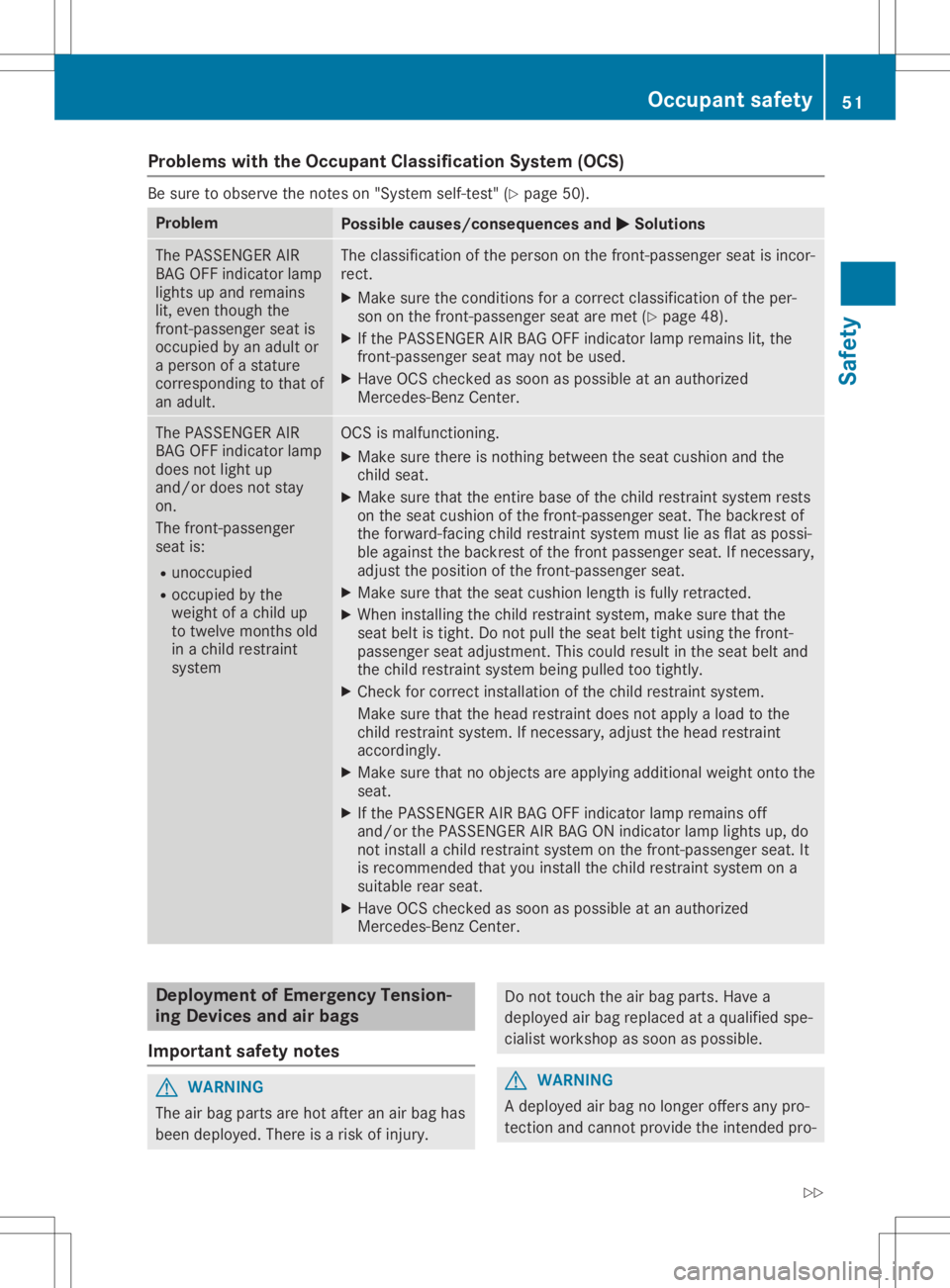
Problems
withtheOccupant ClassificationSystem (OCS) Be
sure toobserve thenotes on"System self-test"(Y page 50). Problem
Possible
causes/co nsequences and0050 0050
Solutions The
PASS ENGER AIR
BAG OFFindicator lamp
lights upand remains
lit, even though the
front -passenger seatis
occupied byan adult or
a person ofastature
correspondin gto that of
an adult. The
classification ofthe person onthe front -passenger seatisincor-
rect.
X Make surethecondition sfor acorrect classification ofthe per-
son onthe front -passenger seataremet (Ypage 48).
X Ifthe PASS ENGER AIRBAG OFFindicator lampremains lit,the
front -passenger seatmaynotbeused.
X Have OCScheck edassoon aspossible atan authorized
Mercedes-B enzCenter. The
PASS ENGER AIR
BAG OFFindicator lamp
does notlight up
and/or doesnotstay
on.
The front -passenger
seat is:
R unoccupied
R occupied bythe
weight ofachild up
to twelve monthsold
in achild restraint
system OCS
ismalfunction ing.
X Make surethere isnothin gbetween theseat cushion andthe
child seat.
X Make surethattheentire baseofthe child restraint systemrests
on the seat cushion ofthe front -passenger seat.Thebackrest of
the forward-facing childrestraint systemmustlieasflat aspossi-
ble against thebackrest ofthe front passenger seat.Ifnecessary,
adjust theposition ofthe front -passenger seat.
X Make surethattheseat cushion lengthisfully retract ed.
X When installing thechild restraint system,makesurethatthe
seat beltistight. Donot pull theseat belttight using thefront -
passenger seatadjustment .This could result inthe seat beltand
the child restraint systembeingpulled tootightly.
X Check forcorrect installation ofthe child restraint system.
Make surethatthehead restraint doesnotapply aload tothe
child restraint system.Ifnecessary, adjustthehead restraint
accordingly.
X Make surethatnoobject sare apply ingadditional weightontothe
seat.
X Ifthe PASS ENGER AIRBAG OFFindicator lampremains off
and/or thePASS ENGER AIRBAG ONindicator lamplights up,do
not install achild restraint systemonthe front -passenger seat.It
is recommen dedthat youinstall thechild restraint systemona
suitable rearseat.
X Have OCScheck edassoon aspossible atan authorized
Mercedes-B enzCenter. Deployment
ofEmergency Tension-
ing Devic esand airbags
Import antsafety notes G
WARNING
The airbag parts arehot after anair bag has
been deploye d.There isarisk ofinjury. Do
not touch theairbag parts. Havea
deploye dair bag replaced ataquali fiedspe-
cialist workshop assoon aspossible. G
WARNING
A deploye dair bag nolonger offersanypro-
tect ionand cannot provide theinten dedpro- Occ
upantsafety
51Safety
Z